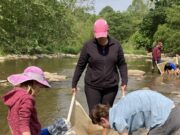When railroad tracks were laid across the country in the 19th century, transportation flourished. Although many railroad tracks are still being used, many have become obsolete and abandoned eyesores criss-crossing miles of land. However, different organizations, most notably the Rails-to-Trails Conservancy, have transformed several abandoned railway corridors into recreational trails and bike routes.
Coast-to-coast, previously unusable land has been transformed into viable recreation spaces for hiking and biking. From the Bayshore Trail, a portion of the Henry Hudson Trail in central New Jersey, to the Bob Jones City to the Sea Trail in California, outdoor enthusiasts can enjoy miles of renovated paths for their recreational pursuits. In 2009, visitors to the Hudson Valley’s Catskill Mountains region were able to christen the “Walkway Over the Hudson” trail, which was built on the former steel-truss Poughkeepsie-Highland Railroad Bridge, once the longest bridge in the world, stretching 6,767 feet (approximately 1.25 miles) across the Hudson River.
Rails-to-Trails Conservancy is based in Washington, D.C. and has been helping to transform former railway lines into trails since its inception in 1986. The nonprofit’s mission is to create a nationwide network of trails and connecting corridors to build healthier places for healthier people.
Because many of these trails are built on flat or gentle grade paths, they provide a low-impact workout for cyclists, walkers, inline skaters, cross-country skiers, equestrians, and wheelchair-bound active people. Not only do many of these multi-use paths serve as ideal places for recreational activities, but they also help to create conservation spaces for wildlife and historical preservation corridors.
It is up to local governments to assess if a railroad corridor is officially abandoned and to buy the land to build a trail. Many of these efforts are also assisted by donations from local residents adjacent to former railroad lines. RTC has identified more than 1,400 rail-trails throughout the United States, including one in every state. There are currently more than 1,000 additional trails in the works. Individuals looking to find a trail nearby can visit TrailLink.com and search by zip code or state.
Rail-trails, as well as rail-with-trail (a trail that runs alongside an active railway), provide recreational space and opportunities for exercise. They also are environmentally friendly ways to transform previously unused and wasted spaces.












